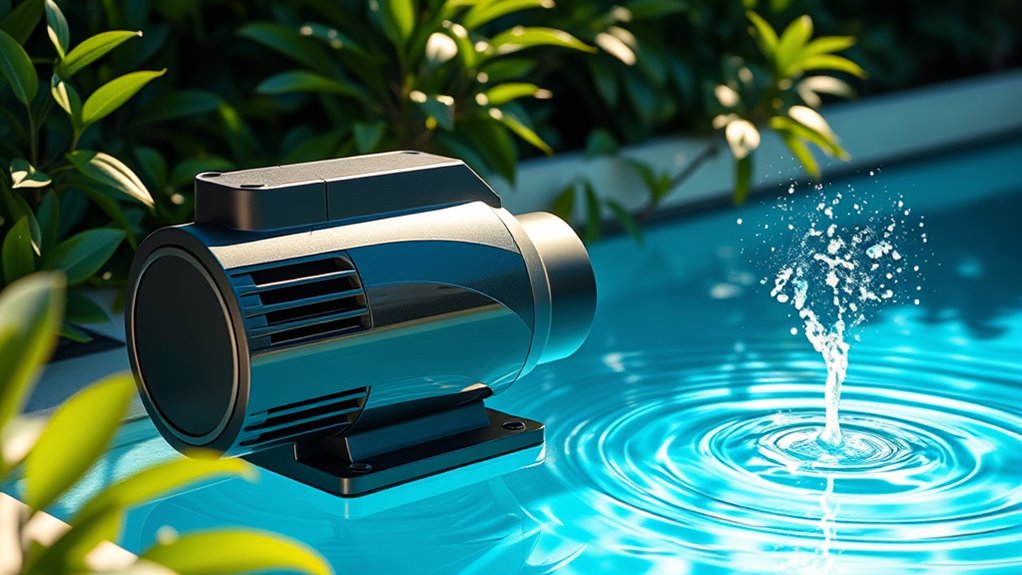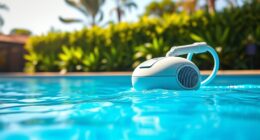Pool energy-saving pumps offer an eco-friendly way to maintain your pool while cutting down on energy costs. These pumps come in various types, such as variable-speed models that adjust their flow for peak efficiency. By using less energy, they help reduce your carbon footprint and support sustainable practices. While the upfront cost might be higher, the long-term savings on your electricity bill make them a smart investment. Discover the benefits and features that can transform your pool care experience.
Key Takeaways
- Energy-saving pumps, such as variable-speed models, optimize energy use and reduce overall consumption, promoting sustainable pool maintenance practices.
- Lower energy consumption from efficient pumps decreases carbon emissions, contributing to a greener environment.
- Dual-speed and variable-speed pumps can significantly reduce electricity bills, making them financially beneficial over time.
- Technological advancements in pump design enhance efficiency and compatibility with various pool systems, supporting eco-friendly practices.
- Investing in energy-efficient pumps encourages environmentally conscious choices among pool owners and supports green technology initiatives.

When you’re looking to save on energy costs while maintaining a pristine pool, energy-saving pumps are the way to go. These pumps come in various types, each designed for different needs and efficiencies. Single-speed pumps run at a constant speed, but they often lack the energy efficiency of more modern options. If you want a little more flexibility, dual-speed pumps might be right for you, as they offer two different speed settings that can save you around 50-75% energy when running at half speed.
However, if you’re looking for the best efficiency, variable-speed pumps take the cake. They adjust to any speed, optimizing energy use and performance.
For unmatched efficiency, variable-speed pumps excel by optimizing energy use and performance at any speed.
The benefits of energy-efficient pumps extend beyond just saving on energy bills. Variable-speed pumps, for instance, allow you to customize flow rates and even come with programmable timers. These features let you set the pump to run at lower speeds during off-peak hours, further reducing energy consumption.
You’ll be amazed how much energy you can save by simply adjusting the pump speed, thanks to the affinity laws that show how reducing speed dramatically decreases energy use. Over time, this leads to significant savings on your electricity bills, making these pumps a cost-effective choice for any pool owner.
Installation and maintenance of these pumps have also improved. Innovative designs like the Jandy ePump or the FloPro Pumps come with adjustable bases, making installation straightforward. Plus, they often require less maintenance, reducing your long-term costs.
If you ever need to replace your pump, modern options are designed to fit various pool systems, ensuring compatibility and ease of upgrade.
While the upfront costs of energy-efficient pumps can be higher, the long-term savings on electricity make them a smart investment. You’ll find that over time, the cost of energy savings can offset that initial expense, leading to a favorable payback period.
Not only do you benefit financially, but you also contribute to a greener environment by reducing your carbon footprint through less energy consumption.
As technology continues to evolve, you can expect even more efficient options to hit the market. Energy-saving pumps aren’t just a trend; they represent a shift towards sustainable pool maintenance. By choosing the right pump, you’re taking a significant step toward a more energy-efficient and environmentally friendly pool.
Frequently Asked Questions
How Do Pool Energy-Saving Pumps Compare to Traditional Pumps?
When you compare pool energy-saving pumps to traditional pumps, you’ll notice significant differences.
Energy-saving pumps consume much less energy, leading to lower utility bills and a reduced carbon footprint. They also offer variable speeds, optimizing performance based on your pool’s needs.
Plus, they run quieter and typically last longer. In the long run, you’ll find that these pumps not only save you money but also support a more sustainable lifestyle.
What Maintenance Do Energy-Saving Pumps Require?
You might think maintaining energy-saving pumps is a hassle, but it’s actually quite straightforward.
Regularly check for debris and clean the filter to keep everything running smoothly. Monitor water levels and circulation hours, aiming for 6-8 hours daily.
Don’t forget to schedule annual professional inspections to catch any hidden issues early.
With a little routine care, you’ll guarantee your pump operates efficiently, saving both energy and money while keeping your pool pristine.
Are Energy-Saving Pumps Compatible With All Pool Types?
Energy-saving pumps aren’t universally compatible with all pool types, but they do work with many designs, including inground and above-ground pools.
You’ll need to take into account the pump’s flow rate and your current filtration system.
Variable speed pumps offer great flexibility, allowing you to adjust settings as needed.
Always check the manufacturer’s specifications to verify the pump fits your specific pool model and installation requires minimal plumbing modifications.
How Much Can I Save on Energy Bills?
You can save considerably on energy bills by upgrading to an energy-efficient pool pump.
For in-ground pools, annual savings can reach around $50, while above-ground pools might save about $20.
Over the lifetime of these pumps, savings can exceed $300.
If you switch to variable speed pumps, you could cut electricity costs by up to 80%.
Do Energy-Saving Pumps Affect Pool Water Circulation?
Yes, energy-saving pumps considerably improve your pool water circulation.
With their variable speed motors, they adjust flow rates based on your pool’s needs, ensuring efficient water turnover.
This optimized circulation distributes chemicals and heat evenly, enhancing water quality.
You’ll notice fewer impurities and better filtration, which means you spend less on chemicals and maintenance.
Conclusion
Switching to energy-saving pumps isn’t just a smart choice; it’s a sustainable choice. You’re not only cutting costs, but you’re also reducing your carbon footprint. By investing in these innovative technologies, you’re embracing efficiency, promoting eco-friendliness, and enhancing your pool experience. So, take the leap—save energy, save money, and save the environment. With every swim, you’re making a difference. Immerse yourself in the future of pool care and enjoy the benefits of going green!









